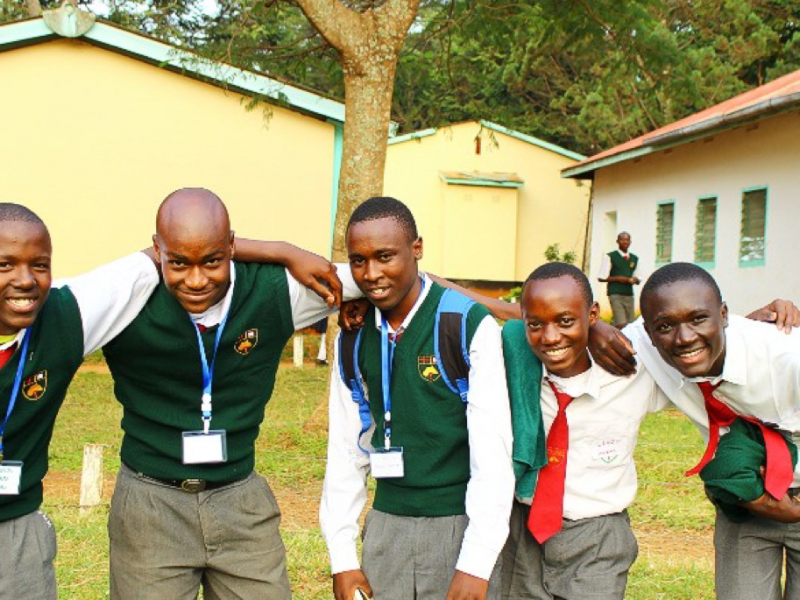[dt_button link=»http://d165vjqq8ey7jy.cloudfront.net/mp3/32955/se-7963s_2.mp3″ target_blank=»true» button_alignment=»default» animation=»fadeIn» size=»small» style=»default» bg_color_style=»custom» bg_color=»#333333″ bg_hover_color_style=»custom» bg_hover_color=»#444444″ text_color_style=»custom» text_color=»#ffffff» text_hover_color_style=»custom» text_hover_color=»#dddddd» icon=»fa fa-cloud-download» icon_align=»left»]Скачать[/dt_button]
[dt_divider style=»thin» /]
Transcript:
Voice 1
Welcome to Spotlight. I’m Liz Waid.
Voice 2
And I’m Colin Lowther. Spotlight uses a special English method of broadcasting. It is easier for people to understand — no matter where in the world they live.
Voice 1
Leroy Mwasaru is 17 years old. He is attending a school in Western Kenya. Mwasaru loves it there. But there are problems. There are too many students in the school. To provide meals for students, the school cooks must spend many hours preparing food with wood stoves. These stoves produce a lot of smoke. The smoke can hurt their eyes and lungs. And recently, Mwasaru’s school has also had another problem. The school toilets have started leaking into the ground. This makes the water too dirty to drink. Many people are becoming sick. But in twenty thirteen Mwasaru found a solution. His solution solved both of these problems. Today’s Spotlight is making energy from human waste.
Voice 2
Leroy Mwasaru’s solution was to build a human waste bioreactor. A bioreactor is a very large container that stores human waste. It also contains millions of microorganisms. These creatures are very small — too small even to see. They do not do very much on their own. But in a group they are very powerful. Microorganisms are able to break waste into smaller parts. But they also release an important gas in the process: methane. Many gas stoves burn methane gas. The bioreactor can bring the methane into the school’s kitchen, where the cooks work. The cooks can use methane to power their stoves. Then, the cooks do not have to breathe smoke. Mwasaru created a clean, safe energy source for his school. And, as long as there are students producing waste, the energy will not end! In an interview with CNN, Mwasaru said
Voice 3
“There were some people who thought it would not work — the attitude was very negative. We created classes in the community and in the school. After that, people became more positive. With the gas, they do not have to spend time searching, and carrying wood. They are really happy about that.”
Voice 1
Mwasaru’s bioreactor is an example of bioenergy. It is an alternative energy source. That is, it is different than energy sources that people normally use, like oil or coal. Most alternative energy is also renewable, like wind or solar energy. This way of making energy depends on natural forces that will not go away. As long as the wind blows or the sun shines, these renewable sources will create energy. Using human waste is also renewable. People’s bodies will always make it. So there will always be this kind of fuel.
Voice 2
But bioenergy is different than other renewable sources. This is because it does more than just make energy. It also gets rid of the human waste. In many countries, human waste causes harm. In some places there are no toilets. Or the toilets do not store waste well. This waste gets into rivers and streams, and they become polluted. People who drink this water can become very sick. Millions of people die every year from dirty water. But bioenergy changes waste into something useful. It lets people USE their waste instead of polluting their environment.
Voice 1
Most ways of making bioenergy are very similar. Almost all of them involve particular microorganisms. These organisms break down solid waste like feces. Some break down foods that can no longer be eaten. These microorganisms produce methane and other gases. Then people can use these gases to create energy. But bioenergy is about more than just cooking! Some people use bioenergy to operate vehicles. Others use the gas to make electricity.
Voice 2
Another way to make bioenergy is called a Microbial Fuel Cell, or MFC. These fuel cells also contain microorganisms, and bacteria. The bacteria eat particular chemicals. But instead of releasing methane, they give off something even more valuable — electricity.
Voice 1
One of the scientists developing this technology is Ioannis Ieropoulos. He is a professor at the Bristol Bioenergy centre in the United Kingdom. But the fuel cells he uses are very different than others. They do not use chemicals like other microbial fuel cells. Instead, they produce electricity from human urine! Urine is liquid human waste. It is mostly water. But it also contains urea. The bacteria in Ieropoulos’ fuel cells produce electricity from urea. This also cleans the urine. Ieropoulos told the BBC:
Voice 4
“What comes out of the MFC is cleaner than the urine that went in. Chemically it is better balanced. People could use it as fertilizer, to help grow plants. The MFC lets us collect other chemicals too. Some are very useful, like the chemical phosphate.”
Voice 2
In the beginning, Ieropoulos’ MFCs did not produce much electricity. But the technology is improving. And people can make it more easily. Many people in the world do not have electricity. The MFCs can provide an easy way to get it. In some places, this technology is already improving people’s lives.
Voice 1
One organization that has a plan to use Microbial Fuel Cells is Oxfam. Oxfam is an organization that works with refugees. In many refugee camps, there is no electricity. Without electric lights, the camps get very dark at night. And it is sometimes dangerous for refugees to go to the toilet. Oxfam will use MFC technology to give the refugee camps electricity. With help from Ieropoulos, they have designed special toilets with lights in them. These lights are powered by the refugee’s waste. The refugees will be able see the toilets. So they will not hurt themselves, or be hurt by others at night. Oxfam will try out these special toilets in refugee camps in late 2016. Someday, with the electricity from more toilets, Oxfam hopes to light whole camps.
Voice 2
Some people believe Bioenergy is the energy of the future. But others are not so sure. The technology is still very new. Scientists still need to make it better. It requires a lot of knowledge to make. And it costs a lot of money. But it could be a way to solve the problem of human waste. Bioenergy could help make the world cleaner for many people. And it can produce energy that will not harm the earth.




